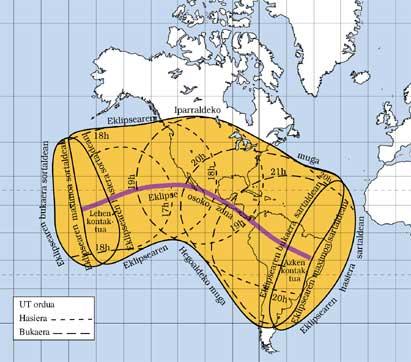Total Solar Eclipse
Easier and Harder Aspects of Sun Eclipses
This type of event has surprised man since ancient times. Now we all know that the eclipse occurs when the Moon is between the Sun and the Earth (or an area of the Earth), so from some places on Earth you cannot see the Sun in a time.
Many times the Moon covers only part of the Sun and this case is called Partial Eclipse. Other times the Moon completely covers the Sun and is then called a total eclipse.
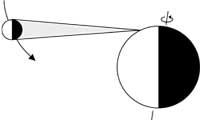
During the partial eclipse, the Sun takes on a typical aspect, as it was broken somewhere. To see it, use a very dark filter. There are no significant changes in the landscape, the brightness slows down a little, but there are very few people who realize it.
The change of light brightness is enormous when a total eclipse occurs. In a short period of time, the dark aspect of the earth, the sky and the sea surprises all people. Formerly this event was considered a disaster. Many people thought the Sun would disappear and that caused panic. Today the eclipse has no sense of panic. But it remains one of the great shows of nature. In addition, there are now many scientific expeditions that travel thousands of kilometers to analyze some aspects of the Sun that the eclipse highlights in a few minutes.
But why is it so surprising to see a total eclipse of the Sun? To understand the characteristics of this phenomenon, we must place ourselves in space and consider the Moon, the Sun and the Earth as spherical bodies located in space. The moon, being a dark and opaque object, creates shadow in the Sun's line in the opposite direction. This shadow extends into space in the form of a long cone. The base of the cone is located on the Moon and the vertex at 370,000 km.
When the Moon moves in its orbit, right between the Sun and Earth, the shadow cone can occupy the surface of our planet, leaving this phenomenon 8 times per decade. But since the distance between the Earth and the Moon is similar to the length of the cone, the Earth cuts the cone almost at the apex. Therefore, the surface of the shadow exerted on Earth is small, in no case exceeding 273 km in diameter.
Only observers included in this circle will be able to see the total eclipse of the Sun. However, this circle is not fixed. As the Moon circulates in its orbit, the shadow cone also moves. Therefore, the intersection of this with the Earth (that is, the small area of shadow mentioned above) moves on the Earth's surface, representing a band of thousands of kilometers in length. This band indicates all the places on Earth where the eclipse will be seen. Despite its large length, its width is small. Therefore, in that band there are usually not many peoples.
Therefore, anyone in this band will be able to see the eclipse. The eclipse will occur when the shadow of the Moon reaches that place and will last the time necessary for the entire shadow to pass through that place. We therefore speak of the duration of the eclipse. The larger the shadow area, the longer it takes to pass through a place, so the eclipse will last longer.
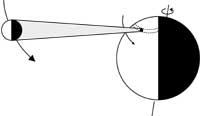
However, the distance between the Earth and the Moon is variable, as the Moon moves around the Earth in an elliptical (and not circular) orbit. When the Moon is further away from the Earth (heyday), this distance is greater than the length of the shadow cone. In this case, the shadow cone is not in contact with the terrestrial surface and then the total eclipse of the Sun is not found.
On the contrary, when the Moon is closer to the Earth (perigee), the shadow cone is cut by the Earth's surface in a circle of 273 km in diameter. When the Moon is in intermediate positions with the Earth, the diameter of the shadow area will vary between 0 and 273 km. The larger the size of the area, the longer it will take to pass through a point on Earth, so the eclipse seen from that point will last longer.
But the duration of the eclipse also depends on the rotation speed of the Earth. We have said that the shadow of the Moon circulates on the surface of the Earth, so the eclipse is seen from different places. This movement is always the same direction (from west to east approximately) and the speed is about 900 m/s. But, at the same time, the Earth's surface is moving from west to east due to Earth's rotation.
Therefore, the shadow velocity is less than 900 m/s of the Earth's surface and, therefore, the duration of the eclipse is greater than if the Earth were paralyzed. How much more? It depends on latitude. The rotation makes the linear velocity of the Earth from west to east maximum in the equator, 400 m/s, and descends as it approaches the poles, being 0 m/s at the poles. Therefore, around the equator, the shadow of the Moon crosses the Earth at an approximate speed of 900 m/s - 400 m/s = 500 m/s and at a speed of 900 m/s - 0 m/s = 900 m/s in polar zones. This is why in the places of equators or tropics there are longer eclipses than in the polar ones.
In short, the two factors that drive a long duration of the total eclipse of the Sun are that the eclipse occurs when the Moon is in the Perigee and that the shadow cone of the Moon rings around the earth's equator.
Conditions Total Eclipse 1991
The eclipse took place on July 11 between 17h 24 min and 20h 48 min (UT or universal hours), when the Moon passes between the Sun and the Earth. The moon passed through the perigee on July 11 at ten in the morning. Therefore, the time between the passage of the Moon by the Perigee and the eclipse was 7 to 11 hours. This is a high degree of coincidence, since the period can vary between 0 and 330 hours.
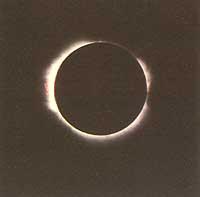
On the other hand, on the way through the Moon that day, the shadow cone cut the surface of the Earth in a stretch of latitude between 26º N and 13º S, that is, in areas close to the equator.
As you can see, the eclipse fulfilled the conditions for its long duration. And so it happened. In some places the duration of the eclipse was 6 min and 53 s, which is a very good time in this type of events. That is why this eclipse was given so much importance and that is why expressions such as the eclipse of the century were used. However, it should be noted that during this century there have been three longer eclipses. The eclipse of June 8, 1937 lasted 7 min 04 s, on June 20, 1955 7 min 08 s and on June 30, 1973 7 min and 03 s. However, to see another eclipse as long as 1991, XXII. We will have to wait until the 20th century.
Natural spectacle
This eclipse could be seen from the center of the Pacific to Brazil. Therefore, the eclipse could be seen from Hawaii, southern California, Mexico, Central America, the Pacific coast, Colombia and Brazil. The best weather conditions of these places during the eclipse were Hawaii, southern California and the Mexican city of La Paz. Scientists, journalists, etc. gathered in these places. each to fulfill its function.
Being in these places the day of the eclipse, sensations are given that cannot be expressed with words. The phenomenon occurred in the morning, noon or afternoon, depending on the place of observation. For example, the San Sebastián and Pamplona expedition took place in La Paz, Mexico. There the eclipse occurred between 11 h 47 min 40 s and 11 h 54 min 02 s.
About an hour and a half before (10 h 23 min) the partial eclipse phase began. At that moment the Moon begins to stand in front of the Sun. It is then observed that the Sun begins to miss or forget part of its edge. Since in this phase the brightness of the Sun is so high, it is necessary to check it with filters. As the minutes advance, the dark part of the Sun increases.
After 30 minutes, the Moon had covered a third of the diameter of the Sun. At that moment there is a slight weakening of the brightness of the environment, similar to that produced when a thin layer of fog covers the sky.
As the Moon continued to eat the Sun, the brightness of the surrounding landscape weakened.

20 minutes before the start of the total eclipse were covered three quarters of the diameter of the Sun; the brightness was becoming weaker and the sky began to darken mostly by the West.
When 12 minutes were missing 85% of the diameter of the Sun was eclipsed and the sky continued to darken, especially to the West.
Within 6 minutes, 90% of the Sun's diameter was eclipsed and the sky blue became anil, especially in the West. The meadows around took a brownish, tetric-like color.
From then on the light disappeared more and more. The brightness of the landscape was losing faster and faster, as if we were opening a dark curtain inside a room. This effect creates a form of disaster outdoors.
In the last seconds all these events intensified until the beginning of the total eclipse. Then the last ray of the Sun's surface (the photosphere) disappeared to see the black sun surrounded by a crown. The crown, inside, had a great shine. However, as the brightness is not enough to damage the view, you could see it directly without filter. As it headed outward to the crown, the luminosity was weaker and it adopts on the outer edge the form of direct light wires (which scatter like radii with the Sun). Not everyone was equal. Some seemed more violent, longer, brighter than others, and the crown profile looked like a striking asymmetric image.
Seeing the eclipsed Sun surrounded by crowns is undoubtedly the most important show, but there were also others. The distribution of light in the sky is also spectacular. On the horizon there is usually an intense luminosity of yellow and orange, similar to the brightness of the shell. But if there is a difference with the real oscillator, that is, the light does not accumulate in a certain direction, but appears in the entire round of the horizon.
A little higher the orange glow turns off and at the top the sky is dark blue, with the brightest planets and stars. In the sky of La Paz we could see the planets Mercury, Artizar, Martitz and Jupiter and the stars Betelgeuse, Rigel and Sirius.
The surprising luminosity makes the Earth landscape also look traditional. There is not as much darkness as at midnight, but a weak ossic-shaped luminosity is maintained. But the origin of this light seems unknown; bodies do not give light and lose color; all this is dark, surprising. Seeing this type of light at noon generates fear and it seems that disaster is about to occur.
But this situation lasts very little. At the end of the total eclipse, the Moon returns to show the bright surface of the Sun. When the first brightness appears, the landscape lights up sharply, as if some white light were illuminated. At first the light is very weak, but as the Moon moves away from the sun, the brightness of the day normalizes.
Another idea that remains in the mind of those who have seen the total eclipse is the short duration of the eclipse, since all those mentioned occur in a few minutes.
Conclusions for science
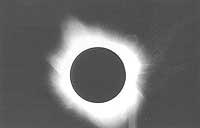
While the total eclipse of the Sun is an exceptional spectacle, for science it is above all a rich source of information. The sun is a physical object that has matter as gas or as plasma. In it there are very high temperatures and thermonuclear transformations occur exchanging large amounts of energy. This indicates that it is a living star, as it has an enormous physical-chemical activity. It is therefore one of the most interesting topics for modern science.
However, only the solar surface (photosphere) is visible and not the internal surface. Astronomers use indirect methods to know the interior of the sun, where the highest temperatures and pressures are obtained and where the most energetic reactions occur.
Outside the photosphere there are different layers that form a type of atmosphere. Here the physical conditions are very interesting, since the gases are exposed to violent radiations from inside the Sun.
These atmospheric layers are not hidden from the sun. However, seeing from Earth is very difficult. The light of the photosphere is so intense and dispersed in the atmosphere that it is not possible to see this atmosphere, even if it is much less than the luminosity of the photosphere.
But in the total eclipses of the Sun the entire photosphere is hidden from view, thus eliminating the dazzling effect. This situation allows, in a few minutes, to visualize, measure or analyze the atmospheric layers of the sun, making as many photos as you want. Therefore, astronomers consider the total eclipse of the Sun as a treasure trove of data. This justifies the organization of expeditions loaded with telescope and camera that are carried out thousands of kilometers to analyze this phenomenon.
Although the type of observations made is very varied, here are only some.
Chromosphere
... It is the lowest layer of the solar atmosphere, that is, the one that directly touches the photosphere. It is seen at the beginning of the entire eclipse, just after the Moon covers the entire photosphere. It has a bright pink color and an arch that surrounds the solar disc. Its width is 10,000 km. As this amount is small on a cosmic scale, as the moon progresses it disappears from sight in a few seconds.
Outgoing
... the highlights that form very hot gases on the chromosphere and are shaped like pink lights that appear at the edge of the sun. The ledges can be seen longer than the chromosphere. It can be said that they can be seen for as long as the eclipse lasts.
Solar crown
... It is the outermost area of the solar atmosphere. It consists of very low density gases, but at very high temperatures (approx. 1,000,000 K). The light they emit has two origins: on the one hand the light that comes and spreads through the photosphere and, on the other, the light emitted by the highly ionized atoms of the area. The result is white clarity. In the eclipse it is perfectly visible and can extend up to twelve times longer than the radius of the Sun.
The crown has a complex structure of filaments, since the gases are oriented according to the magnetic fields of the Sun. This layer is the transition phase between the Solar and space. The Crown, in its limits, becomes Solar Wind. The solar wind is the ionic current that moves outside the Sun. Particles have no brightness, can reach Earth and can affect our atmosphere.
Future eclipses
When will we see an eclipse of the Sun in Euskal Herria? Taking the term of the next ten years, we will have three eclipses, but all will be partial.
May 10, 1994 will take place in the late afternoon and cover 70% of the diameter of the Sun.
On October 12, 1996, at three in the afternoon, the other 50% of the diameter of the Sun will be covered.
On August 11, 1999 at 12 noon, 80% of the diameter of the Sun will be covered.
In order to see the total eclipse in Euskal Herria we have to wait until August 12, 2026. The total eclipse can be seen in Bizkaia, Álava and Navarra at eight and a half pm. In Gipuzkoa a partial eclipse will be observed covering 95% of the diameter of the Sun.
Other total eclipses in areas close to the Basque Country are:
- August 11, 1990 at 12:30 noon in northern France and southern Germany.
- 2 August 2027 to mid-morning from Cadiz, Malaga and Gibraltar.
